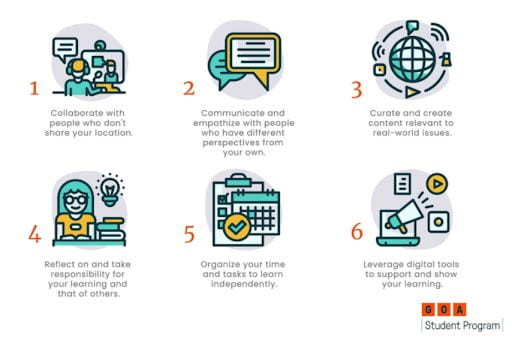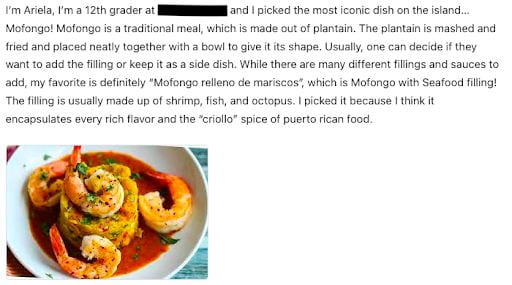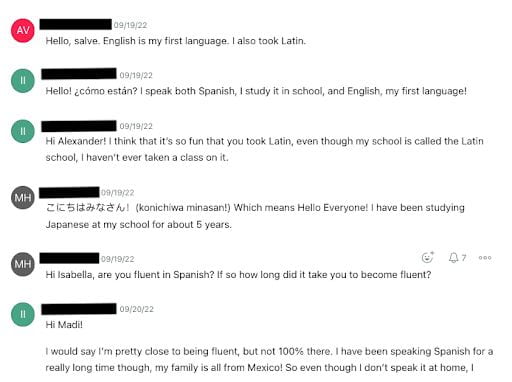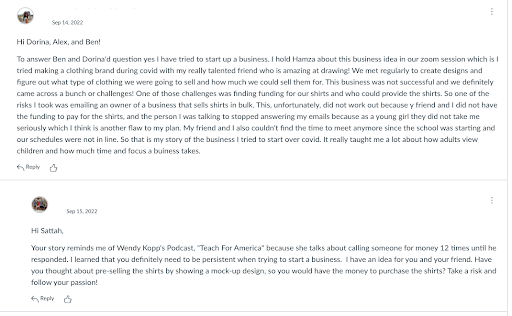As a writer, I am often reminded to keep the main thing the main thing. It is no different for education. No matter how we may dice it, the main thing is, was, and always will be relationships. Research brims with evidence supporting the fact that people are more likely to learn from those they know, like, and trust. The impetus for transferring this understanding might simply be an invitation for teachers to be their authentic selves.
Whatever the latest buzz, hopefully we are not distracted from the main thing. The fact is that education ultimately comes down to people. People are dependent on feeling like they belong, a part of a community. To develop such community, especially in an online setting, is artistry but also requires intentionality. Community and belonging do not just happen.
So, how might we create classrooms, or better yet, experiences where students know but also feel that who they are matters? At Global Online Academy (GOA) courses bridge students from a diverse set of economic and cultural backgrounds, while also juxtaposing asynchronous and synchronous learning across various time zones. We might end up connecting at 6pm in Hawaii, while it is 7am in Riyad, Saudia Arabia. Yet are we really “connecting.” Meaning, how might we intentionally design learning so relationships are forged, so the reality of community can emerge?
Keeping six core competencies on our dashboards, front and center, it behooves us to consider how we might foster collaboration with people who don’t share our location. Early and often! As well, how will we provide opportunities for students to communicate and empathize with people who have different perspectives from their own? Further, how might we leverage digital tools to support and show learning? All three competencies are concentrated on, in an effort to build a culture of learning. A culture grounded in trust. Where the foundation is more a “we” than “me” mindset. Inherent in this work is also the competency to reflect on and take responsibility for our learning but also the learning of others.
To accomplish all of this is akin to painting Starry Night. Maybe even while peering up at a cloudy midnight sky. Yet, if we keep the main thing the main thing, we might be surprised by our inner van Gogh!

From Theory to Practice
One of Einstein’s many famous quotes was, “In theory, theory and practice are the same. In practice, they are not.” This illustrates how there is a difference between abstraction and actual application. Like talking about riding a bike and actually riding one. If the purpose again is the “main thing,” relationships, it seems sensible that application or how we might go about this be considered.
In an in-person setting, there is a higher probability for relationships to organically happen. In the hallways, at lunch, or possibly with the person sitting next to who the teacher says is your “turn and talk” partner. However, online relationship building is clearly different. Anyone who was learning, working, or teaching during the pandemic (that’s all of us!) likely already knows this. They lived it. YOU lived it! For all we may have learned from online learning and working, there seemingly was a quick recoil to 2019 and an illusion that we could just “go back to normal.” The same as it ever was, a reminder of the Talking Heads waxing poetic in, “Once in a Lifetime.”
Into the blue again, after the money’s gone
Once in a lifetime, water flowing underground
Same as it ever was, same as it ever was.
Only, nothing ever returns to the same as it ever was.
Instead, the world as we know it is one where the systems are fast dissolving. Knowing this firsthand, we have a sort of moral obligation to create online opportunities to support learners in developing relationships. Not just student to teacher, but student to student.
In our Entrepreneurship in a Global Context GOA course, the first weeks are crafted in a way that students are introduced to content, and yet the design is principally around building culture. Our culture as a class, one which seems to seamlessly parallel what we refer to as, the mindset of an entrepreneur. What surfaces are characteristics such as passion, awareness, and the importance of feedback.
TWIST and Shout!
PEW Research Center reported how in 2010, 72% of all teens text messaged. Surely in the last twelve years, this number has only risen. Informed of this preferred communication style, GOA was wise and embraced a platform or “tool” for students and teachers to communicate “informally.” Twist, an async messaging app helps make collaboration easy as learners are spread across the globe. With Twist, conversations are organized into threads, supporting students as they reach out one to another socially but also collaboratively in their course work. The idea we inherited from previous course designers is in effort to familiarize students with Twist, however, the purpose is twofold in that not only do students begin to feel more comfortable with the app, but they also begin to create community. A few tasks are asked, below are two examples:
–In #RANDOM CHATTER (the channel) post a pic of a food from your region (dish from a specific restaurant? Iconic food of your region? Meal you’d cook?). Then, tell us why you picked it.

–Go to your Twist group. Mr. Piercy (me!) sent you all a message in it. Do you see it? Share hellos with your group in each language you fluently speak or are studying. ( i.e from Mr. Piercy: “Hello, Buenos dias.” (English is my first language but I am fluent in Spanish). *Watch that Twist channel space. Use that space. Have a question? Want to know others’ thoughts? Wonder if you’re on the right track? Have something to share? Challenge yourself to reach out at least twice over this module in that channel. And please, listen to others and respond when they post.

Discussion Boards
With all differing process speeds, asynchronous discussions elicit a depth of thought that might otherwise not be possible. Students are asked to post their thinking but also take the time to listen, or in effect, read what their classmates are saying. Often, initial student responses tend to be simple affirmations. We challenge students to bend away from the “I agrees.” Considering global contexts, discussion boards are “fertile ground” for students to develop different perspectives. Further, might they share anecdotes, include observations, and even share resources? The idea is to extend each other’s learning. As one community.
Of course, careful consideration is to be taken in when designing pre-activities and questions. This is to spark a depth of discussion. A discussion that ultimately promotes connection.

Video Cannot Be Overlooked
The Buggles’ 1979 debut single, “Video Killed the Radio Star,” centers on a concern for how 20th-century inventions might alter life and lead to the generation of today possibly not appreciating the past. Besides the catchy jingle, the song title is repeated 17 times over the course of a little more than three minutes. “Video Killed the Radio Star,” was decades before YouTube and TikTok. It even predated the days of “Be Kind and Re-wind” and the VHS (bonus: VHS stood for Video Home System). Yet, The Buggles were on to something. There would be little looking back and video was here to stay. So much so, that instead of looking back, it would become commonplace to have a kinked neck because of our looking down; at phones!
Fast forward to today and the use of video. To consume but also create. The New York Times reports, “TikTok is already the world’s most downloaded app for those ages 18 to 24.” So ubiquitous that in September of 2021, global statistics reported 1 billion monthly users.
To know this is to own it.
We as educators have an obligation to utilize the medium of video. In a GOA course, consistent attention must be paid to being personable. How might teachers and students alike present our “real” selves? One idea, borrowed from colleague Jim Burns, is the “One Minute, One Take.” This broad brush stroke introductory video at the start of each module drips with authenticity. Following this, embedded throughout the module are other purposeful videos. Some more tutorial-based, others clarifying, or possibly even explicitly teaching. The flavors and textures of the videos are different, while the common denominator is what lies behind. This notion of connectedness, always remembering to keep the main thing the main thing, relationships.
Reflecting Forward
Students also have a chance to feature their bad hair, blunders, and “real” selves as they are asked from time to time to create videos too. In an effort to get to know students better, at the end of our first module, students do a 3-minute or less reflective video. They are asked to just talk to the camera, as well they are given a few prompts to consider. For example:
~what are your biggest takeaways?
~how has your thinking shifted relative to x, y, or z?
~what were the influences on how your thinking is changing?
There always is an invitation to share lingering questions, challenges that have arisen, and anything exciting in their lives. I recently heard about twin sisters, volleyball matches, and even a 3-day sail up the coast of Croatia.
A sort of celebratory closure is a video response in return for each student. Likened to a 1:1 conference, only asynchronous and through the well-received medium of video, this helps personalize learning. Yet one more shift in practice to hopefully add to that feeling of belonging. Mindful to keep the main thing the main thing.
###############
